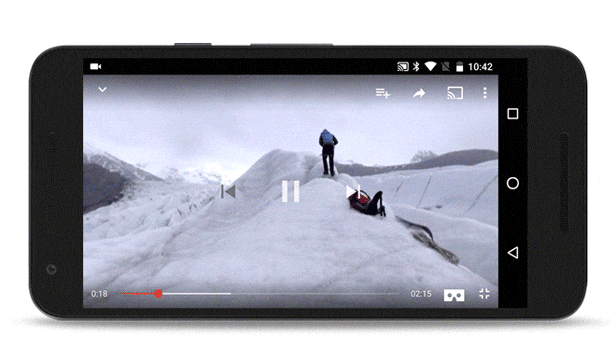New York Times Virtual-Reality Documentary Is Moving But Occasionally Nauseating
In the space of 20 minutes yesterday, I stared down a large gorilla in a Congo forest, visited a glacier and a beach in Iceland, and cycled through a half-destroyed Ukrainian suburb with kids displaced by war. By the end of it I had a feeling that short virtual-reality movies could become a powerful and popular medium—and was slightly motion sick.

Those experiences came after I put my smartphone inside a Google Cardboard viewer that lets a device function as a simple but effective VR headset. I used it to try out a new app from the New York Times with a heart-rending virtual-reality documentary about children displaced by war, and a new kind of “VR video” that now appears on YouTube. (Get a Cardboard viewer and find the footage via Google or the New York Times; the newspaper is sending 1.1 million Cardboard viewers to subscribers this weekend.)
Google is using its Cardboard viewer to try to make using your phone for virtual reality into a news, entertainment, and education medium (see “Google Aims to Make VR Hardware Irrelevant Before It Even Takes Off”). The new experiences released by Google and the New York Times today are the most sophisticated yet created for the platform.
The New York Times has created a mobile app for the Cardboard viewer to show off a short documentary about children displaced by war. The 11-minute film takes you to visit three children between the ages of nine and 12 in South Sudan, Ukraine, and Lebanon. It demonstrates the power of mobile virtual reality for movies, but also some limitations.
The moment a plane arrives to drop food to a boy named Chuol and other refugees in South Sudan shows the power that virtual-reality filmmaking can have. I heard the plane before I could see it, and turned my head and looked at the faces of the refugees around me to find it. Then I watched it drop a trail of large white sacks that thudded into the ground. Everyone around me started shouting as they ran to pick them up.
There were many other striking moments. But some were marred by the limitations of the technology. When the camera put me inside Chuol’s canoe as he pushed it out of a bank of reeds into a swamp the scene was beautiful, but I felt motion-sick. The sensation returned when the camera rode along with 11-year-old Oleg in Ukraine and his friends on their bikes.
Those scenes might have been less biologically troubling had I been using higher quality virtual reality hardware. The Oculus Rift headset launching next year is better at minimizing the lag between the motion of a virtual world and that of your head, which is one cause of motion sickness. But badly chosen or design content can make you sick, too. Filmmakers have much to learn about what kind of footage they can get away with. I’d say that at 11 minutes the New York Times documentary is slightly too long for the current state of mobile virtual reality technology and the art of immersive 3-D filmmaking.
The new VR video footage I tried on YouTube didn’t make me feel so woozy, even when, for example in this clip, you are placed on a ferry moving away from a city. In that case, Google employees working on virtual reality told me that they carefully chose a clip in which the ferry moved with a constant velocity. Most people are okay with smooth motion, they said; it is changes in speed that cause problems.
The New York Times app shows another limitation of the format. Virtual-reality video requires much more data than ordinary 2-D footage. The app informs you that to watch the 11-minute documentary, your phone has to download 329 megabytes. A promotional virtual-reality clip from GE also bundled with the app is less than three minutes long, and another 78 megabytes.
Even with these problems, the new content is impressive. Short, powerful, and compelling virtual-reality experiences can be delivered by your phone. As companies learn from this first round of content, they should craft even better films for us to get lost in. The fact that GE and BMW’s Mini offered promotional content for the New York Times app suggests that there may even be a business model.
Experience tells us that any new media format also becomes host to a lot of bad content, though. That could pose a problem for the popularity of virtual-reality videos. Badly made TV and YouTube videos don’t (usually) make you physically ill. I didn’t much mind experiencing a little nausea in the name of trying out something new yesterday. But for virtual-reality movies to become popular, that will need to be an infrequent occurrence.
Keep Reading
Most Popular
How scientists traced a mysterious covid case back to six toilets
When wastewater surveillance turns into a hunt for a single infected individual, the ethics get tricky.
The problem with plug-in hybrids? Their drivers.
Plug-in hybrids are often sold as a transition to EVs, but new data from Europe shows we’re still underestimating the emissions they produce.
What’s next for generative video
OpenAI's Sora has raised the bar for AI moviemaking. Here are four things to bear in mind as we wrap our heads around what's coming.
Stay connected
Get the latest updates from
MIT Technology Review
Discover special offers, top stories, upcoming events, and more.